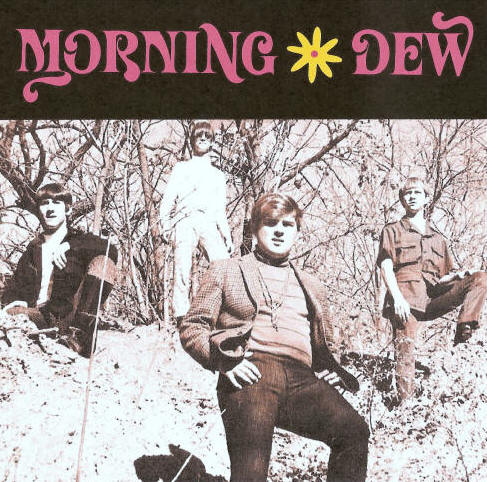
THE MORNING DEW- NO MORE (1966-69) $12.98

THE MORNING DEW- No More, 1966-1970
1 No More (unreleased alternate version)
2. I'm Not Your Steppin' Stone
3. Touch Of Magic
4. Look At Me Now
5. No More
6. Be A Friend
7. Go Away
8. Winter Dreams
9. Sycamore Dreamer
10. Then Came The Light
11. Cherry Street (unreleased stereo version)
12. Rainbow Woman (unreleased stereo version)
13. Lady Soul (unreleased stereo version)
14. Money Honey Blues (unreleased stereo version)
15. Sing Out
16. Young Man
17. Get Together
18. KEWI Radio July, 1967 Tour Interviews
19. Look At Me Now (alternate version)
(Total time 64 minutes)
In 1963, Mal Robinson formed an
instrumental group called The Impax. The band would only last for six
months. Robinson then formed in quick succession, The Runaways
and The Durations (an Anglo rhythm and blues band with horns). In February
of 1966, Mal formed a folk-rock band, The Toads. The members of
this group were Mal Robinson (12-String guitar and lead vocals)and Don Shuford (Bass guitar). No recordings were ever made by any
of the aforementioned bands. brother of Sligar at Washburn University
in Topeka was added to the group to play rhythm guitar. The Morning Dew
began playing at high school dances, fraternity parties, and rehearsing in
Sligar’s 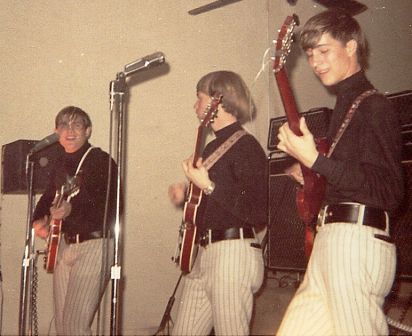 garage to hone their skills. Musical influences for The Morning
Dew were groups such as The Lovin’ Spoonful, The Critters and The Cyrkle.
In August of 1966, The Morning Dew traveled the thirty miles from Topeka to
Lawrence to record a four-song demo at Audio House. Audio House was the
same studio where local legends The Blue Things did many of their
recordings. The Morning Dew recorded two cover songs and two original
songs. “This Sportin’ Life” was a follow up hit by Ian Whitcomb to his
smash hit, “You Turn Me On”, which became a staple of The Morning Dew’s live
shows and they would re-record this song again two years later during the
Fairyland Recording sessions of July-August, 1968. The other cover song done
at Audio House was the b-side to The Monkees’ second hit “I’m A Believer”,
“I’m Not Your Steppin’ Stone”, but pre-dates that single by four months.
The Morning Dew based their version of “Steppin’ Stone” on Paul Revere and
The Raiders performance off their “Midnight Ride” album. “Winter Dreams” and
“Touch Of Magic” were written by Robinson and displayed a growing
sophistication in the band’s sound compared to just a few months earlier,
when they had a softer edge to their songs. While, none of Audio House
songs would ever see a release during The Morning Dew’s career, they helped
garner attention from booking agents and record promoters.
garage to hone their skills. Musical influences for The Morning
Dew were groups such as The Lovin’ Spoonful, The Critters and The Cyrkle.
In August of 1966, The Morning Dew traveled the thirty miles from Topeka to
Lawrence to record a four-song demo at Audio House. Audio House was the
same studio where local legends The Blue Things did many of their
recordings. The Morning Dew recorded two cover songs and two original
songs. “This Sportin’ Life” was a follow up hit by Ian Whitcomb to his
smash hit, “You Turn Me On”, which became a staple of The Morning Dew’s live
shows and they would re-record this song again two years later during the
Fairyland Recording sessions of July-August, 1968. The other cover song done
at Audio House was the b-side to The Monkees’ second hit “I’m A Believer”,
“I’m Not Your Steppin’ Stone”, but pre-dates that single by four months.
The Morning Dew based their version of “Steppin’ Stone” on Paul Revere and
The Raiders performance off their “Midnight Ride” album. “Winter Dreams” and
“Touch Of Magic” were written by Robinson and displayed a growing
sophistication in the band’s sound compared to just a few months earlier,
when they had a softer edge to their songs. While, none of Audio House
songs would ever see a release during The Morning Dew’s career, they helped
garner attention from booking agents and record promoters.
Towards the end of 1966, The Morning Dew
attracted the attention of an agent for Fairyland Productions (a booking
agency and production company in Columbia, Missouri) Larry Knouft. Knouft
let Lou Rennau know about the talent of The Morning Dew. Rennau was a former
member of a Columbia band called Goldilocks And The 3 Bears. Rennau heard
the demo tape, liked what he heard and signed the band to his fledging
Fairyland Productions. The Fairyland recording studio was at Corn’s Lake in
Columbia. In April of 1967, The Morning Dew entered Fairyland studios to
record their first single, which would also become Fairyland Records’ first
release. Robinson who didn’t read music worked out the melody and lyrics for
both songs. It took ten hours to record the tracks at Fairyland
Productions, spread out over two days, and ten takes before “No More” and
“Look At Me” were perfected. The cost to the band was $200, the fee for
renting Fairylands’ studio and sound equipment. The Dew then sent the
record to Memphis where a record production company mixed it. The band paid
$400 for two thousand copies to be pressed. Five hundred copies were
distributed to Topeka merchants.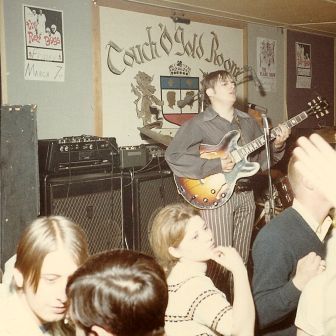
In a Topeka newspaper article dated July
14, 1967, Robinson stated that “the record has sold well in Topeka, but we
don’t know exactly how many have sold.” Sligar stated, “It’s gone from 40
to 9 to 15 to 20 on the Kewi radio station. The secret is in the
distribution. We have distributed it in three states and its being played
on nine radio stations. What we need is one breakthrough”. Shuford said
“Most records linger locally for three months before they come to national
attention-if they ever do, we’ll just let it ride-see if it sells or if it
doesn’t”. The “No More” single was responsible for The Morning Dew’s growing
regional success. The band received bookings in Nebraska, Missouri,
Arkansas, Oklahoma, and Kansas. In St. Joseph, Missouri, over 1,400 persons
showed up for a Morning Dew performance and 500 in Seneca. By now, The
Morning Dew’s show was a frantic four to five hour opus that included
original numbers and cover songs. Three psychedelic songs were performed in
which strobe lights casted multicolored lights on the band as they played.
Robinson would stand his red Gibson-E335 on the
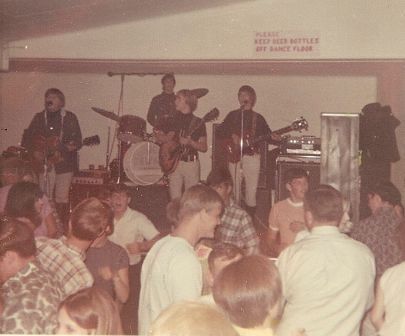 stage and run around it
while it was emitting feedback and also throw it in the air and catch it
just before it hit the floor. Unfortunately, on a few nights he missed and
didn't catch it so the body was cracked and beat up needing tape to keep it
together. The band also developed a harder edge to its sound and was neck
and neck with the local Topeka competition, like The Thingies, The Jerms,
and The Burlington Express. They also began to dress in the mod psychedelic
clothes of the era, with an op-art look. Some of The Dew’s
stage and run around it
while it was emitting feedback and also throw it in the air and catch it
just before it hit the floor. Unfortunately, on a few nights he missed and
didn't catch it so the body was cracked and beat up needing tape to keep it
together. The band also developed a harder edge to its sound and was neck
and neck with the local Topeka competition, like The Thingies, The Jerms,
and The Burlington Express. They also began to dress in the mod psychedelic
clothes of the era, with an op-art look. Some of The Dew’s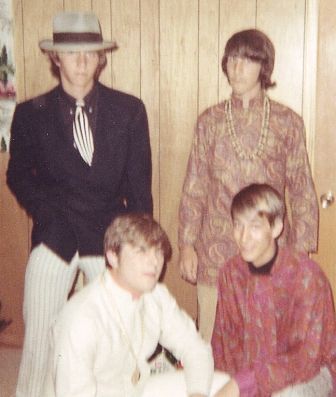 influences on
their ever-progressing sound were bands such as The Yardbirds, The Cream,
The Buffalo Springfield, The Beatles, and The Rolling Stones. Robinson
would sum up the Dew’s attitude succinctly by saying “we want to go all the
way and always wanted to. When we first started, we would watch other bands
and we’d think that maybe someday we’d be on stage performing with all the
crowds and the screaming”. Fan mail started to pour in for the band. One
enamored fan wrote “I am the little girl that was in front of you when you
were at Mound City Saturday night. I haven’t washed my hand because you all
gave me your names on it”. Another fan wrote, “I think you are all really
groovy. I especially like the one with kind of blondish hair”. The M
influences on
their ever-progressing sound were bands such as The Yardbirds, The Cream,
The Buffalo Springfield, The Beatles, and The Rolling Stones. Robinson
would sum up the Dew’s attitude succinctly by saying “we want to go all the
way and always wanted to. When we first started, we would watch other bands
and we’d think that maybe someday we’d be on stage performing with all the
crowds and the screaming”. Fan mail started to pour in for the band. One
enamored fan wrote “I am the little girl that was in front of you when you
were at Mound City Saturday night. I haven’t washed my hand because you all
gave me your names on it”. Another fan wrote, “I think you are all really
groovy. I especially like the one with kind of blondish hair”. The Morning Dew was drawing between $200 and $350
for one-night stands and Fairyland Productions took 20 percent as agent's
fees.
On July 16, 1967, The
Morning Dew opened a month long stand at a nightclub near Bagnell Dam in the
Missouri Ozarks, playing four nights a week till August 11. And to tie in
with their performances KEWI radio (the
number one AM rock radio station in Topeka) broadcast live on the air daily
interviews by phone with The Morning Dew. The accelerated pace of the bands
popularity rendered them ready to enter Fairyland studios for their second
single, “Be A Friend” b/w “Go Away” after their month long Ozark stint.
Tommy Smith from Goldilocks And The 3 Bears played lead guitar on “”Go
Away”. Ken Tebow, leader of Plato &The Philosophers, helped with
background vocals on “Be A Friend”. Another connection between The Morning
Dew and Plato & The Philosophers was by accident. Plato and The Philosophers
released a single for Fairyland Records, titled “Thirteen O’clock Flight To
Psychedelphia” and an error in the pressing of the single resulted with The
Morning Dew’s song “No More” being on some of the copies that were initially
pressed! At any rate, The Morning Dew’s second single charted in the top 30,
but sales were nowhere near their first single. Many people affiliated with
The Morning Dew thought they should have released “Go Away” as the a-side,
as it was more consistent with the “No More” style, the band wanted to show
their versatility with a folk-rock sound in “Be A Friend”.
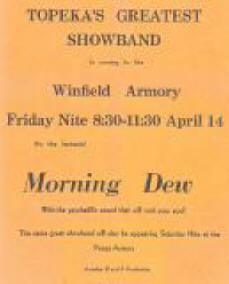
The Morning Dew’s
popularity as a live band did not suffer from the second single’s failure to
hit the top ten on the radio. They opened for The Drifters in Wichita,
Kansas at the Red Dog Inn and for Gary Puckett and The Union Gap at the
Topeka Municipal Auditorium. They shared a billing with the Strawberry Alarm
Clock at the Experimental Light Farm in Manhattan Kansas. Another concert
was when The Turtles were in Emporia Kansas at the Municipal Auditorium and
The Morning Dew opened the show. The Turtles were upset with The Morning Dew
for using strobe lights and a smoke machine because they thought it was
screwing up the stage for their subsequent performance but more than likely
because the Dew psyched them out. While a live set list does not exist from
1967, a mid-1968 set list does and the songs that The Morning Dew were
playing live are listed in their original order as follows: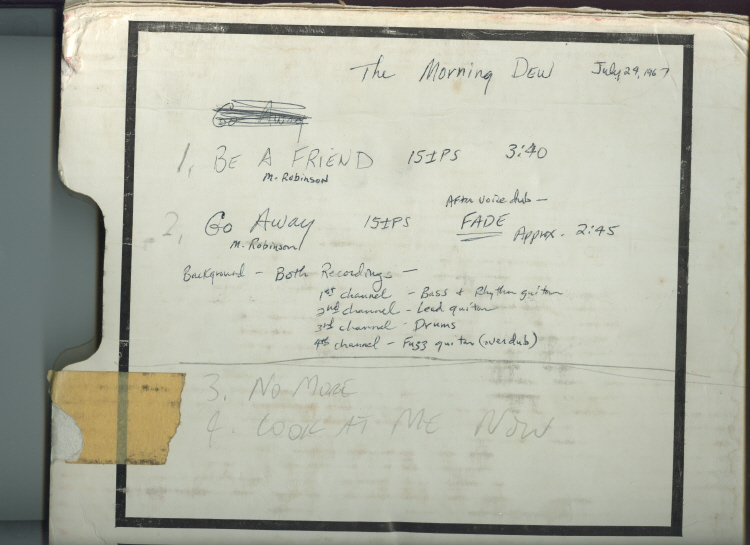
First Set-Wake Me Shake Me, Dancin’ In The Street, Gimme Some Lovin’, Come On Up, The Other Side Of This Life, Don’t Let The Sun Catch You Crying, Keep On Running, Mr. Blues, Sweets For My Sweet, Hey Joe, Respectable, This Sportin’ Life, Heat Wave, Hip Hug Her. Second Set- Sunshine Of Your Love, Mr. Soul, Purple Haze, You Don’t Know Like I Know, Midnight Hour>Respect, Words (The Bee Gees Song), Gloria, Murder In My Heart For The Judge, No More, Even The Bad Times Are Good, Hip Hug Her. Third Set-Ride My See Saw, Knock On Wood, All Over The World, To Love Somebody, I’m A Man, Get Out Of My Life Woman, The Train Kept A Rollin’, Born To Be Wild.
The next recording
sessions by The Morning Dew were done during the dates of July 24-25, August 6
to 11, and August 25 to 26, 1968. Ten songs were
recorded, eight of them penned by Robinson. He reflected on the songs of
The Morning Dew by saying "We're the Morning Dew
twenty four hours a day, so we've got plenty of time to do this". Regarding
the suggestive drug and sex references in song lyrics by many bands Robinson
said that "anyone can write a dirty song, besides, if you're not high on
drugs, it's hard to write about it". The changes from
their previous singles could be explained in one word “psychedelic”. The
influence of The Beatles’ “Sgt. Pepper” album is evident on the opening
band playing that segues into what becomes “Sycamore Dreamer” with its eerie
John Lennon phased vocals and lyrics. “Then Came The Light” features
Robinson on the wah-wah pedal while guest Lou Rennau plays the weird
sounding oscillator. Dubbed over the break is a message from Robinson,
similar to the Jimi Hendrix monologue in his psychedelic masterpiece “If 6
was 9”. “Then Came The Light” , “Cherry Street” and “Something You Say”
would all show up later on The Morning Dew’s highly collectible Roulette
album, issued in 1970 (albeit in different versions). “Lady Soul” was The
Morning Dew’s sarcastic reply to the fans at their shows that asked the band
to play some soul music. Robinson’s clever use of a double tracked fuzz
guitar sound blended with help from the Missouri University Marching Band on
horns turns the song into a odd blend of psychedelia and soul.
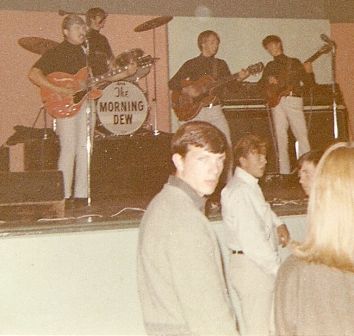
The ten-song
demo tape was circulated around to record labels and A & R men. Sligar
stated “What helps so many other groups is the fact that they are in big
cities, nobody from a record company is going to come to Topeka to hear a
band somebody tells them is pretty good, you’ve got to take it to them”. A
stroke of good luck occurred when a local agent, was able to secure The
Morning Dew a contract with Roulette Records. This occurred in the fall of
1968. A promoter/investor from Columbia, Pete Shanaberg (an affiliate of
Lou Rennau) took the ten song demo tape with recordings from other Midwest
acts (Don Cooper, Morgan Mason Downs) to New York and peddled these tapes to
record companies. Consequently, Shanaberg was successful in obtaining record
deals with Roulette Records for all the acts. Due to the time that had
expired from the 1968 Fairyland recordings, Roulette wanted
to hear some current recordings of the group so The Morning Dew recorded
“Get Together” and “Young Man” in May of 1969 but both tracks were never
released (although “Young Man” was later issued on the Roulette album, it
was a different recording). Unfortunately, Shuford had already left the
band due to the draft and was replaced by former Burlington Express member,
Blair Honeyman on the two recordings.
A producer for Roulette, Fred Munao came to Topeka in June 1969 to hear The Morning Dew perform live. He was so impressed with the band that a recording contract was signed the day he came to hear them in Topeka. In August of 1969, The Morning Dew drove their van up to New York for the Roulette album recording sessions. The album was recorded in three days. Three of the 11 songs recorded for Roulette had been previously done the year before at Fairyland Studios, “Cherry St.”, “Then Came The Light”, and “Something You Say”. Seven other songs were new Mal Robinson originals. The band submitted to Roulette a proposed album cover but it was rejected in favor of a photo of a hippie couple in the nude on the verge of making love or finding the answer to life’s mysteries. Unfortunately the album was delayed for unknown reasons and released in September 1970, over a year since its inception. The album received little promotion from Roulette and sold poorly, but today is recognized as a classic with original copies going for over a hundred dollars.
Prior to the release of the Roulette album
The Morning Dew drove down to Audio House for one last time in the summer of
1970. They embarked on a marathon recording session that resulted in a
seven song master tape. Mal Robinson wrote all of the songs. The band now
included Ferdy Baumgart instead of Don Shuford and Dave Howell on keyboards
and guitar. The Audio-House tape revealed a harder rocking band than they
were when the Roulette album was recorded. Ironically the Roulette album
had laid on the shelf for over a year and came out a month after the band’s
Audio House session! The 1970 Audio House recording was done for producer
Fred Munao of Roulette. The Morning Dew’s contract called for a second album
and this was original material the band wanted for the album. For various
reasons, Roulette never honored the second album in their contract with the
band. The lack of success with the Roulette album and growing disenchantment
with the music business caused The Morning Dew to disband in May of 1971.
The irony of these words by Mal Robinson in the July 14, 1967 Topeka
newspaper article would ring ever so incandescent-“If we really hit it big,
I don’t know, if the money was good enough we’d probably take off for a year
and risk the draft. We don’t even think about failing, we just think about
success.” While the Morning Dew never garnered national attention and
success, the recordings on this CD amply prove that they were one of the
finest late 60’s bands to emerge from Kansas.